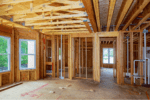Note: Distinguished Programs no longer offers Builder’s Risk or Vacant Building insurance through our City Insurance division. Explore our other programs for tailored solutions.
Many people are unaware that unoccupied and vacant buildings often pose greater insurance risks than those that are occupied. Without anyone present to catch early signs of trouble, theft and vandalism can become more likely, while minor issues like small leaks can escalate into major flooding.
That’s why it’s crucial that your clients get comprehensive Unoccupied Property Insurance for any of their properties that are empty or without tenants. This article will outline the details of this kind of insurance policy, including what Unoccupied Property Insurance is, who needs it, and what insurance brokers need to offer in a policy to win new clients.
What Is Unoccupied Property Insurance?
Unoccupied Property Insurance (also called Vacant Home, Vacant Property, and Empty Home Insurance) is an insurance policy that provides coverage for an empty building that isn’t under renovation or construction.
Oftentimes, Unoccupied Property Insurance is bought for short periods of time, usually between three months and a year. During that time, it protects your client’s property investments by offering property coverage and, sometimes, general liability coverage until the building gets back into use, either through construction, renovation, or occupancy.
What Is the Difference Between Vacant and Unoccupied?
The difference between vacant and unoccupied properties boils down to whether the building has been outfitted with everything necessary for someone to move in and use it. If it has possessions but no people, then it’s unoccupied. If it has nothing, people or possessions, then it’s vacant.
For instance, if a homeowner is on a year-long trip around the world and has left all their possessions, furniture, appliances, etc., in their home, that home would be considered unoccupied. However, if they planned on selling that house after their trip and moved all their things to storage, then that home would be vacant.
The same distinction applies to commercial properties. An office space between tenants that still has all of its furnishings would be unoccupied, while the same office space that had been gutted in preparation for a future renovation would be vacant. It’s important to note that in certain circumstances, like multi-unit housing or commercial office spaces, up to 30% occupancy can be allowed to qualify as unoccupied. In contrast, single-family homes must be 100% vacant.
Who Needs Unoccupied Property Insurance?
Unoccupied or Vacant Property Insurance is necessary for any client who has a building that’s temporarily not in use — even if it won’t be that way for long.
This could include:
- Commercial spaces that are between tenants
- Homes that are being staged for selling
- Larger condominiums that are waiting on renovations
- Office buildings that are waiting to be sold
- Restaurant spaces before their open date
Although certain other insurance policies like Builder’s Risk, Commercial Property, or Homeowner’s Insurance may cover a vacant or unoccupied building for a little while, these grace periods are usually quite short.
In fact, in most cases, 30-60 days is all your clients will have until they need a dedicated Vacant or Unoccupied Property Insurance policy.
For instance, many people mistakenly think their Builder’s Risk policy will be good enough while a missing permit or contractor issue is delaying their planned renovations or construction. However, many Builder’s Risk policies only cover vacant buildings for a short period of time.
With Distinguished’s Builder’s Risk Insurance, coverage for vacant properties is only valid for up to 45 days at the beginning of a project if construction has been delayed. After that, if the building remains vacant, it could result in the denial of a claim.
Why Do Clients Need Unoccupied Property Insurance?
Every day, accidents that require insurance coverage occur all over the United States. In many instances, those incidents occur in unoccupied and vacant buildings because they are unsupervised.
This lack of supervision encourages criminals to steal or vandalize, and it also means small issues like leaks can turn into thousands of dollars worth of property damage before someone notices.
So, here are just a few examples of why your clients need comprehensive Unoccupied Property Insurance to protect their assets.
7/11 Catches Fire Waiting for Renovations
In January 2024, a vacant New Jersey 7/11 caught fire, sustaining massive damages. Although the total damage isn’t completely known, the average fire at a retail business like that can easily total $18,000.
If a property was waiting for renovation and had sat empty for as little as one or two months, their Builder’s Risk Insurance may not cover the fire damage. That means the property owner would need to cover the damages themselves if they hadn’t bought a Vacant Property Insurance policy.
String of Burglaries at Unoccupied Homes
Empty homes are easy targets for thieves. If they know the building isn’t occupied, it’s easy enough for them to break in and take what they want without anyone even realizing they were there until much later.
In some areas, this problem has become so bad that it’s even making the news. A recent wave of burglaries in Bellevue, Washington, hit one home with over $150,000 in stolen items. In these cases, the burglars broke in, scouted the place, and then came back the next day with a truck to haul off all of their appliances and valuables.
In these instances, it’s important to invest not just in better home security but also in a dedicated insurance policy so your clients can recover from their losses.
What Does Unoccupied or Vacant Property Insurance Cover?
Although it will differ from policy to policy, at Distinguished, our Unoccupied or Vacant Property Insurance covers the following:
- Theft: Covers any items stolen while the covered property is unoccupied or vacant
- Vandalism: Covers damages done to a vacant or unoccupied property, such as graffiti or broken windows
- Water damage: Covers water damage caused by sources like burst pipes or sprinkler leakage.
- Mold: Offers limited coverage up to $15,000 for things like rot, fungus, or mold
Our coverage also comes with some extras, like:
- Coverage for loss to the undamaged portion of a building (subject to policy provisions)
- Coverage for fire department service charges
- Coverage for debris removal (subject to policy provisions)
Finally, Distinguished also offers optional general liability coverage for Unoccupied or Vacant Building Insurance policies. GL coverage can be beneficial when your clients expect there to be people around the premises, like a security guard or property manager.
How Much Does Unoccupied Property Insurance Cost?
Unoccupied property insurance costs are highly dependent on the specific situation of your client. When determining a quote, our underwriting team will consider factors like:
- TIV of the building
- Property location
- Construction type
- Unique exposures of that building
- Deductible amount
For this reason, the only real way to know how much Unoccupied Property Insurance will cost your client is to get a quote directly from us.
Luckily, at Distinguished, applications for Vacant or Unoccupied Building Insurance are 100% online. Plus, nearly 70% of all applications need no review by an underwriter, so you get a bindable quote immediately after submitting.
To get started, simply register with us (if you haven’t already done so) and then submit your business through our online portal.
Why You Should Partner With Distinguished
When you partner with Distinguished, you get access to our Unoccupied Home and Vacant Property Insurance program.
This program offers your clients comprehensive coverages that are suitable for all kinds of properties — from single-family homes to mixed-use commercial buildings.
Partnering with Distinguished also gives you other distinct advantages, including:
- Flexible terms: Clients rarely know how long a building will be vacant, so we offer 3, 6, and 12-month terms that can be easily extended if your client’s plans change.
- Open to all types of construction: Our program is designed for single and multi-family dwellings, commercial, and mixed-use buildings
- All online: Applications are primarily done through our online portal, which is nearly instantaneous. In cases where manual reviews are required, you should get a quote in 1 or 2 days.
- Convenient coverage options: Based on your client’s needs, we’re happy to insure based on Actual Cash Value or Replacement Cost.
- General Liability optional: For clients worried about liability concerns, we can bundle GL coverage alongside the broad property coverage they’re already getting.
- Low minimum premiums: Our expert underwriters can help keep premiums low so you can serve even more clients looking for this kind of coverage.
These benefits make Distinguished the perfect one-stop shop for all of your Vacant and Unoccupied Property Insurance needs. If you have any questions about this program, feel free to read our program page or reach out to one of our insurance experts.






